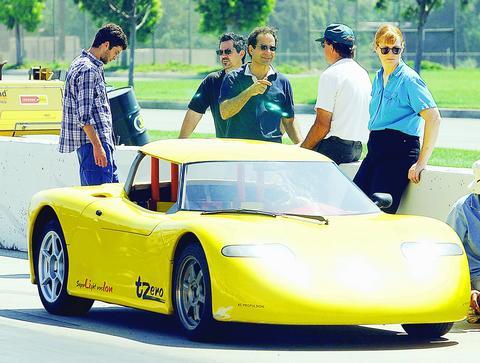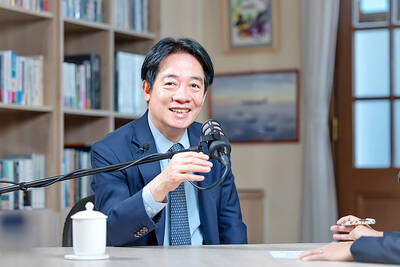"OK, you hit this button," says Alan Cocconi, pointing to a control on a little G-force meter attached to his dashboard. "Then hold down the brake really hard. Push on it with all your might. When it says `Go,' let off the brake and hold on."
With that he steps out of the car. A flat, stretch of asphalt is dead ahead; alongside lies the runway of Brackett Field Airport east of Los Angeles.
With the throttle and brake pedals fully pressed, the bright yellow sports car shudders with power -- but rather than the roar of a caged Lamborghini, the only sound is a muffled whine. Though the whine becomes only marginally louder when the brakes are released, everything else changes as the car lunges forward in a jaw-dropping, stomach-clenching and near-terrifying blur. In less than 4 seconds, it's all over. The Tzero by AC Propulsion, has reached 100kph. And its only power is from a simple array of lithium-ion laptop computer batteries.

PHOTO: NY TIMES
Few street-legal automobiles are capable of running to 100kph in under four seconds, and it's a safe bet that the Tzero is the only electric-powered car that can. The founders of AC Propulsion, based in San Dimas in the suburbs east of Los Angeles, seem to think that the lithium-ion batteries have led them to the holy grail of electric motoring: range and performance in one package. This is, however, after the major automakers have cast aside ideas of all-electric vehicles and turned their attention to hybrids and fuel cells.
Thunderously fast but whisper quiet, the rear-wheel-drive Tzero began life in the late 1990s as a showcase for AC Propulsion's high-revving AC 150 drive system. A 220-horsepower street-legal racer, the car was powered by a series of deep-cycle automotive lead acid batteries. With 570kg of batteries on board, the original car was good to reach 100kph in just over 4 seconds with a top speed of 144kph and a range of 130km to 145km.
Last month, however, AC Propulsion unveiled the latest version of the car, now powered by 6,800 lightweight lithium-ion laptop computer batteries. With these batteries -- and an increased top speed -- the Tzero weighs 316kg less and the company says it will run up to 480km on a single charge -- which requires a few hours plugged into a 220-volt outlet like the ones many households have for clothes dryers. It can also be recharged at a 110-volt outlet, but it takes about three times as long.
The car, priced at US$220,000, is available only directly from AC Propulsion and has not yet met federal safety regulations. The company says, though, that it is legal for street use when registered as a "special construction vehicle," which is the way homemade and kit-built cars are registered. The Tzero at the speedway had a California license plate and had been driven to the track. So far, the company said, deposits have been made for eight cars with the lithium-ion system. (Two earlier versions, with lead acid batteries, were sold for private use.)
What will a Tzero buyer get?
The Tzero beats the acceleration US$281,000 Lamborghini Murcielago, the US$224,000 Ferrari 575M Maranello or the US$440,000 Porsche Carrera GT. And do it cleanly and quietly. However, with the single-gear Tzero's engine limited to just over 160kph at 13,300 rpm's, it will never win an oval-track race against those supercars.
But its developers are betting that the car's power and range will generate renewed interest not only in their company' race car driver and an engineer. Cocconi founded AC Propulsion just over a decade ago after having worked for General Motors as a founding engineer on the company's Saturn EV1 electric car project. Cocconi said he decided to go out on his own after GM decided to build the car.
"I didn't want to be a part of the big GM machine," he said. "About a month afterward, I thought about upgraded chargers and what techniques were possible and I started AC Propulsion." With that, he ripped the engine and transmission out of a Honda CRX and set to work devising his own drive system. Today, 250,000km later, he said, that Honda is still humming.
Gage met Cocconi while working as an automotive industry consultant on electric vehicles in the early '90s. "When I interviewed Alan," Gage said, "it became obvious that not only did he clearly know what he was talking about, but he was doing something about it. I drove a prototype of his and was blown away." A year later, he said, the consulting work dried up and he joined AC Propulsion.
The company's early days coincided with California's Zero Emissions Vehicle or ZEV mandate. When it appeared that automakers would be required to sell a substantial number of ZEVs, manufacturers were a primary customer for AC Propulsion's systems for evaluation.
When the mandate was challenged by manufacturers in 2001, Cocconi said, sales dried up. Today the company sells its US$25,000 EV conversions to private enthusiasts and to bus companies. Gage said that the lithium-ion setup, and plans to offer a conversion system for Toyota's Scion xB, could chart a new course for a company that today has only 12 full-time employees. Gage said that he and Cocconi realized that they could never produce a car with the economies of scale of a Honda or a Toyota.
"That's how the Tzero was born; it's a niche," Gage said. "We knew it would be expensive because it was hand-built in-house, but it would justify its price because it would have outstanding performance."

Nvidia Corp yesterday unveiled its new high-speed interconnect technology, NVLink Fusion, with Taiwanese application-specific IC (ASIC) designers Alchip Technologies Ltd (世芯) and MediaTek Inc (聯發科) among the first to adopt the technology to help build semi-custom artificial intelligence (AI) infrastructure for hyperscalers. Nvidia has opened its technology to outside users, as hyperscalers and cloud service providers are building their own cost-effective AI chips, or accelerators, used in AI servers by leveraging ASIC firms’ designing capabilities to reduce their dependence on Nvidia. Previously, NVLink technology was only available for Nvidia’s own AI platform. “NVLink Fusion opens Nvidia’s AI platform and rich ecosystem for

‘WORLD’S LOSS’: Taiwan’s exclusion robs the world of the benefits it could get from one of the foremost practitioners of disease prevention and public health, Minister Chiu said Taiwan should be allowed to join the World Health Assembly (WHA) as an irreplaceable contributor to global health and disease prevention efforts, Minister of Foreign Affairs Lin Chia-lung (林佳龍) said yesterday. He made the comment at a news conference in Taipei, hours before a Taiwanese delegation was to depart for Geneva, Switzerland, seeking to meet with foreign representatives for a bilateral meeting on the sidelines of the WHA, the WHO’s annual decisionmaking meeting, which would be held from Monday next week to May 27. As of yesterday, Taiwan had yet to receive an invitation. Taiwan has much to offer to the international community’s

CAUSE AND EFFECT: China’s policies prompted the US to increase its presence in the Indo-Pacific, and Beijing should consider if this outcome is in its best interests, Lai said China has been escalating its military and political pressure on Taiwan for many years, but should reflect on this strategy and think about what is really in its best interest, President William Lai (賴清德) said. Lai made the remark in a YouTube interview with Mindi World News that was broadcast on Saturday, ahead of the first anniversary of his presidential inauguration tomorrow. The US has clearly stated that China is its biggest challenge and threat, with US President Donald Trump and US Secretary of Defense Pete Hegseth repeatedly saying that the US should increase its forces in the Indo-Pacific region

ALL TOGETHER: Only by including Taiwan can the WHA fully exemplify its commitment to ‘One World for Health,’ the representative offices of eight nations in Taiwan said The representative offices in Taiwan of eight nations yesterday issued a joint statement reiterating their support for Taiwan’s meaningful engagement with the WHO and for Taipei’s participation as an observer at the World Health Assembly (WHA). The joint statement came as Taiwan has not received an invitation to this year’s WHA, which started yesterday and runs until Tuesday next week. This year’s meeting of the decisionmaking body of the WHO in Geneva, Switzerland, would be the ninth consecutive year Taiwan has been excluded. The eight offices, which reaffirmed their support for Taiwan, are the British Office Taipei, the Australian Office Taipei, the